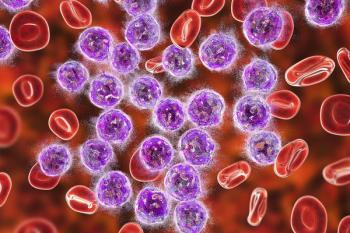
- ONCOLOGY Vol 14 No 11
- Volume 14
- Issue 11
Response of Metastatic Angiosarcoma to Thalidomide: Possible Synergism With Radiation Therapy
A 67-year-old female developed metastatic angiosarcoma involving the scalp, left neck, and pulmonary nodules. Disease progression occurred while she received two cycles of doxorubicin/ifosfamide (Ifex)/mesna (Mesnex), complicated by sepsis
A 67-year-old female developed metastatic angiosarcoma involving the scalp, left neck, and pulmonary nodules. Disease progression occurred while she received two cycles of doxorubicin/ifosfamide (Ifex)/mesna (Mesnex), complicated by sepsis and pneumonia. Radiation was used to palliate tumor bulk in the neck (4,000 cGy in 16 fractions) with a minor response (< 10%) lasting 2 months. Upon disease progression in all three sites, oral thalidomide (Thalomid) was begun at 150 mg three times daily.
During a 6-week period, the neck mass had an 84% shrinkage (from 7.5 ´ 5 cm to 3 ´ 2 cm), while the scalp and pulmonary lesions remained unchanged. Toxicity was limited to somnolence, responding to dose reduction to 100 mg three times daily. After 2 months, thalidomide was stopped because of pulmonary progression with hemothorax and bronchopleural fistula. Progression also occurred in the scalp, but the size of the neck lesion remained unchanged up until the patients demise 3 months later from pulmonary complications.
CONCLUSION: Thalidomide may have a synergistic role for combined-modality therapy of angiosarcoma. Integration of thalidomide into a clinical trial of chemoradiotherapy would be feasible, straightforward, and merits evaluation.
Articles in this issue
about 25 years ago
Clinical Oncology, Second Editionabout 25 years ago
Early Diet May Play Important Role in Breast Cancer RiskNewsletter
Stay up to date on recent advances in the multidisciplinary approach to cancer.

















































































